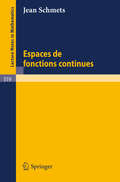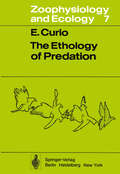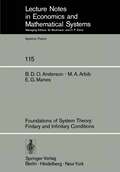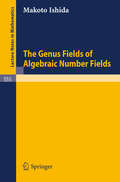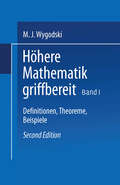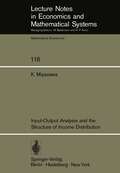- Table View
- List View
Equations over Finite Fields: An Elementary Approach (Lecture Notes in Mathematics #536)
by W.M. SchmidtErgodic Theory on Compact Spaces (Lecture Notes in Mathematics #527)
by M. Denker C. Grillenberger K. SigmundThe Ethology of Predation (Zoophysiology #7)
by E. CurioPredation is an ecological factor of almost universal importance for the biol ogist who aims at an understanding of the habits and structures of animals. Despite its pervasive nature opinions differ as to what predation really is. So far it has been defined only in negative terms; it is thought not to be par asitism, the other great process by which one organism harms another, nor filter-feeding, carrion-eating, or browsing. Accordingly, one could define predation as a process by which an animal spends some effort to locate a live prey and, in addition, spends another effort to mutilate or kill it. Ac cording to this usage of the word a nudibranch, for example, that feeds on hydroids would be a predator inasmuch as it needs some time to locate col onies of its prey which, after being located, scarcely demand more than eating, which differs little from browsing. From the definition just proposed consumption of the prey following its capture has been intentionally omit ted. Indeed, an animal may be disposed of without being eaten. Hence the biological significance of predation may be more than to maintain nutrition al homeostasis. In fact, predation may have something in common with the more direct forms of competition, a facet that will be only cursorily touched upon in this book.
Expectations and Stability in Oligopoly Models (Lecture Notes in Economics and Mathematical Systems #138)
by K. OkuguchiEver since A.C.Cournot(1838), economists have been increasingly interested in oligopoly, a state of industry where firms producing homogeneous goods or close substitutes are limited in number. The fewness of firms in oligopoly gives rise to interdependence which they have to take into account in choosing their optimal output or pricing policies in each production period. Since each firm's profit is a function of all firms' outputs in an oligopoly without product differ entiation, each firm in choosing its optimal output in any period has to know beforehand all other rival firms' outputs in the same period. As this is in general impossible, it has to form some kind of expecta tion on other firms' most likely outputs. Cournot thought that in each period each firm assumed that all its rivals' outputs would remain at the same level as in the preceding period. Needless to say, the Cournot assumption is too naive to be realistically supported. However, the Cournot profit maximizing oligopoly model characterized by this assumption has many important and attractive properties from the view point of economic theory and provides a frame of reference for more realistic theories of oligopoly. In Chapters 1-3, we shall be engaged in analyzing the Cournot oligopoly model in greater detail from the viewpoints of existence, stability, uniqueness and quasi-competitive ness of the equilibrium.
Foundations of Econometrics (ISSN #Volume 7)
by Albert MadanskyAdvanced Textbooks in Economics, Volume 7: Foundations of Econometrics focuses on the principles, processes, methodologies, and approaches involved in the study of econometrics. The publication examines matrix theory and multivariate statistical analysis. Discussions focus on the maximum likelihood estimation of multivariate normal distribution parameters, point estimation theory, multivariate normal distribution, multivariate probability distributions, Euclidean spaces and linear transformations, orthogonal transformations and symmetric matrices, and determinants. The manuscript then ponders on linear expected value models and simultaneous equation estimation. Topics include random exogenous variables, maximum likelihood estimation of a single equation, identification of a single equation, linear stochastic difference equations, and errors-in-variables models.The book takes a look at a prolegomenon to econometric model building, tests of hypotheses in econometric models, multivariate statistical analysis, and simultaneous equation estimation. Concerns include maximum likelihood estimation of a single equation, tests of linear hypotheses, testing for independence, and causality in economic models. The publication is a valuable source of data for economists and researchers interested in the foundations of econometrics.
Foundations of Optimization (Lecture Notes in Economics and Mathematical Systems #122)
by M. S. Bazaraa C. M. ShettyCurrent1y there is a vast amount of literature on nonlinear programming in finite dimensions. The pub1ications deal with convex analysis and severa1 aspects of optimization. On the conditions of optima1ity they deal mainly with generali- tions of known results to more general problems and also with less restrictive assumptions. There are also more general results dealing with duality. There are yet other important publications dealing with algorithmic deve10pment and their applications. This book is intended for researchers in nonlinear programming, and deals mainly with convex analysis, optimality conditions and duality in nonlinear programming. It consolidates the classic results in this area and some of the recent results. The book has been divided into two parts. The first part gives a very comp- hensive background material. Assuming a background of matrix algebra and a senior level course in Analysis, the first part on convex analysis is self-contained, and develops some important results needed for subsequent chapters. The second part deals with optimality conditions and duality. The results are developed using extensively the properties of cones discussed in the first part. This has faci- tated derivations of optimality conditions for equality and inequality constrained problems. Further, minimum-principle type conditions are derived under less restrictive assumptions. We also discuss constraint qualifications and treat some of the more general duality theory in nonlinear programming.
Foundations of System Theory: Finitary and Infinitary Conditions (Lecture Notes in Economics and Mathematical Systems #115)
by Brian D.O. Anderson Michael A. Arbib E. G. ManesThis paper is one of a series in which the ideas of category theory are applied to problems of system theory. As with the three principal earlier papers, [1-3], the emphasis is on study of the realization problem, or the problem of associating with an input-output description of a system an internal description with something analogous to a state-space. In this paper, several sorts of machines will be discussed, which arrange themselves in the following hierarchy: Input process Machine Output process (Tree automaton) Machine ~ ~ State-behavior Machine I Adjoint Machine .(Sequential Machine) ., I Decomposable Machine (Linear System, Group Machine) Each member of the hierarchy includes members below it; examples are included in parentheaes, and each example is at its lowest possible point in the hierarchy. There are contrived examples of output process machines and IV state-behavior machines which are not adjoint machines [3], but as yet, no examples with the accepted stature of linear systems [4], group machines [5, 6], sequential machines [7, Ch. 2], and tree automata [7, Ch. 4].
Frobenius Distributions in GL2-Extensions: Distribution of Frobenius Automorphisms in GL2-Extensions of the Rational Numbers (Lecture Notes in Mathematics #504)
by Serge Lang Hale TrotterFunction Theoretic Methods for Partial Differential Equations: Proceedings of the International Symposium Held at Darmstadt, Germany, 12-15 April 1976 (Lecture Notes in Mathematics #561)
by V. E. Meister N. Weck W. L. WendlandGewöhnliche Differentialgleichungen: Eine Einführung (Heidelberger Taschenbücher #110)
by Wolfgang WalterGrundlagen Konvexer Optimierung (Lecture Notes in Economics and Mathematical Systems #137)
by R. WetsThe Homology of Iterated Loop Spaces (Lecture Notes in Mathematics #533)
by F. R. Cohen T. J. Lada P. J. MayThe Hopf Bifurcation and Its Applications (Applied Mathematical Sciences #19)
by J. E. Marsden M. McCrackenThe goal of these notes is to give a reasonahly com plete, although not exhaustive, discussion of what is commonly referred to as the Hopf bifurcation with applications to spe cific problems, including stability calculations. Historical ly, the subject had its origins in the works of Poincare [1] around 1892 and was extensively discussed by Andronov and Witt [1] and their co-workers starting around 1930. Hopf's basic paper [1] appeared in 1942. Although the term "Poincare Andronov-Hopf bifurcation" is more accurate (sometimes Friedrichs is also included), the name "Hopf Bifurcation" seems more common, so we have used it. Hopf's crucial contribution was the extension from two dimensions to higher dimensions. The principal technique employed in the body of the text is that of invariant manifolds. The method of Ruelle Takens [1] is followed, with details, examples and proofs added. Several parts of the exposition in the main text come from papers of P. Chernoff, J. Dorroh, O. Lanford and F. Weissler to whom we are grateful. The general method of invariant manifolds is common in dynamical systems and in ordinary differential equations: see for example, Hale [1,2] and Hartman [1]. Of course, other methods are also available. In an attempt to keep the picture balanced, we have included samples of alternative approaches. Specifically, we have included a translation (by L. Howard and N. Kopell) of Hopf's original (and generally unavailable) paper.
Inequalities in Mechanics and Physics (Grundlehren der mathematischen Wissenschaften #219)
by G. Duvant J. L. Lions1. We begin by giving a simple example of a partial differential inequality that occurs in an elementary physics problem. We consider a fluid with pressure u(x, t) at the point x at the instant t that 3 occupies a region Q oflR bounded by a membrane r of negligible thickness that, however, is semi-permeable, i. e., a membrane that permits the fluid to enter Q freely but that prevents all outflow of fluid. One can prove then (cf. the details in Chapter 1, Section 2.2.1) that au (aZu azu aZu) (1) in Q, t>o, -a - du = g du = -a z + -a z + -a z t Xl X X3 z l g a given function, with boundary conditions in the form of inequalities u(X,t»o => au(x,t)/an=O, XEr, (2) u(x,t)=o => au(x,t)/an?:O, XEr, to which is added the initial condition (3) u(x,O)=uo(x). We note that conditions (2) are non linear; they imply that, at each fixed instant t, there exist on r two regions r~ and n where u(x, t) =0 and au (x, t)/an = 0, respectively. These regions are not prescribed; thus we deal with a "free boundary" problem.
Input-Output Analysis and the Structure of Income Distribution (Lecture Notes in Economics and Mathematical Systems #116)
by K. MiyazawaThe purpose of this study is in keeping with the shift in concern over the eco nomic problems of growth to those of income distribution in recent years. Income distribution problems may be analyzed by not only the traditional procedures, but also by some extensions of the input-output technique as I shall demonstrate in this volume of the Lecture Notes. Some fruitful results are obtained by applying the extended input-output technique to income analysis as well as to output analysis. This volume consists of three parts. These parts may be viewed along two veins, with some overlapping unavoidable: (1) Parts One and Two contain extensions of the input-output analysis and (2) Parts One and Three contain studies of the effects of the structure of income distribution on some other economic relationships. First, as an extension of the input-output analysis, we present a synthesis of the Leontief interindustry matrix multiplier and the Keynesian income multiplier in disaggregated form, and introduce a new concept which may be called the "Interrela tional Income Multiplier" as a matrix. It is designed to analyze the interrelation ships among various income-groups in the process of income formation through the medium of industrial production activity. Although this multi-sector multiplier follows from Leontief's interindustry matrix multiplier, it is formulated by the inclusion of the income generation process, which is omitted in the usual input output open model, and by projecting the multiplier process into not only the output determination side, but also into the income-determination side.
Interpolation Spaces: An Introduction (Grundlehren der mathematischen Wissenschaften #223)
by J. Bergh J. LöfströmThe works of Jaak Peetre constitute the main body of this treatise. Important contributors are also J. L. Lions and A. P. Calderon, not to mention several others. We, the present authors, have thus merely compiled and explained the works of others (with the exception of a few minor contributions of our own). Let us mention the origin of this treatise. A couple of years ago, J. Peetre suggested to the second author, J. Lofstrom, writing a book on interpolation theory and he most generously put at Lofstrom's disposal an unfinished manu script, covering parts of Chapter 1-3 and 5 of this book. Subsequently, LOfstrom prepared a first rough, but relatively complete manuscript of lecture notes. This was then partly rewritten and thouroughly revised by the first author, J. Bergh, who also prepared the notes and comment and most of the exercises. Throughout the work, we have had the good fortune of enjoying Jaak Peetre's kind patronage and invaluable counsel. We want to express our deep gratitude to him. Thanks are also due to our colleagues for their support and help. Finally, we are sincerely grateful to Boe1 Engebrand, Lena Mattsson and Birgit Hoglund for their expert typing of our manuscript.
Introduction to Analytic Number Theory (Undergraduate Texts in Mathematics)
by Tom M. Apostol"This book is the first volume of a two-volume textbook for undergraduates and is indeed the crystallization of a course offered by the author at the California Institute of Technology to undergraduates without any previous knowledge of number theory. For this reason, the book starts with the most elementary properties of the natural integers. Nevertheless, the text succeeds in presenting an enormous amount of material in little more than 300 pages."-—MATHEMATICAL REVIEWS


